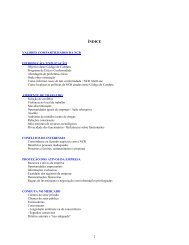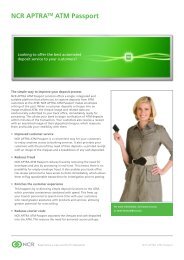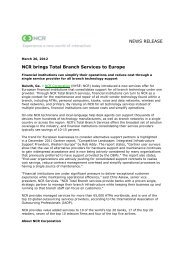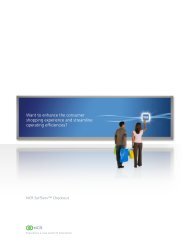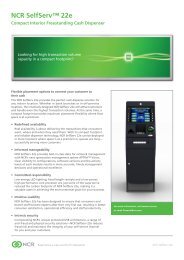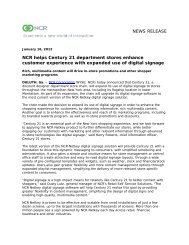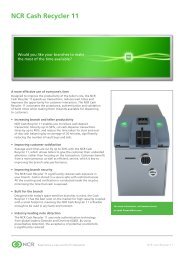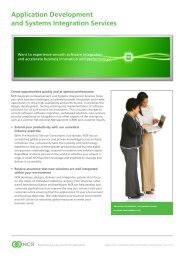Financial Inclusion White Paper - NCR
Financial Inclusion White Paper - NCR
Financial Inclusion White Paper - NCR
Create successful ePaper yourself
Turn your PDF publications into a flip-book with our unique Google optimized e-Paper software.
5.3.2 Independent and Shared Access Networks<br />
a. Independent Networks<br />
Banks can independently deploy technology solutions to deliver financial<br />
services to the financially underserved population through their network of<br />
branches. Micro Finance Institutions (MFIs), Self-Help Groups (SHG) and<br />
Regional Rural Banks (RRB) have greater penetration than traditional banks<br />
amongst the financially underserved masses due to their geographic spread.<br />
There are about 3.37 million SHGs and about 750 registered MFIs in India. An<br />
SHG-Bank linkage program has been one of the most successful initiatives<br />
post independence for delivering financial services to the financially<br />
underserved population.<br />
All the above participants can deliver services using technology either<br />
independently or collaborate and create a common technology platform and<br />
shared network for their delivery.<br />
b. Shared Access Networks<br />
A shared service model spreads the cost of set-up, installation and operation<br />
across the different units within an organization or different organizations that<br />
use the service. Sharing a service increases efficiency and overall service<br />
levels. As such, a shared service (such as a physical or computing network, a<br />
delivery channel or a technology) offers a feasible solution for achieving wider<br />
and deeper financial inclusion.<br />
As well as its 155,000 post offices, India has a network of 12 million retail<br />
outlets that includes vast numbers of small, family-run neighborhood ‘kirana’<br />
stores.<br />
This retailing base, together with the wireless telecoms network offers a huge<br />
‘shared network’ that can be utilized to reach out to the unbanked population.<br />
These retailers from a financial inclusion perspective are strategically located<br />
and are spread extensively across urban slum areas and villages. They serve<br />
not only the lower strata of society but the rich and middle-class populations,<br />
as well.<br />
The retail potential has not yet been explored and offers a ready solution for<br />
cost-effective and efficient delivery of financial services, overcoming what is<br />
currently a prohibitive bottleneck in the entire value chain.<br />
The following three case studies demonstrate the success of shared services:<br />
36




